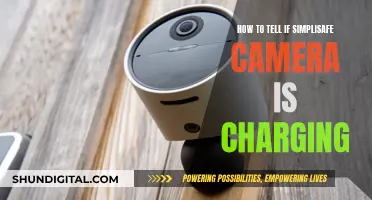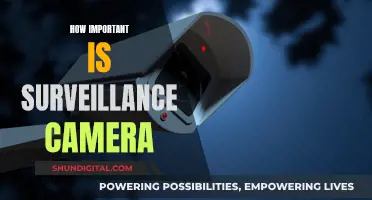
If you've been in a road traffic accident in New York, you might want to obtain traffic camera footage to help your case. However, this might not be possible because most traffic cameras are not set up to record footage. Some cameras are set up for law enforcement purposes, and you may be able to obtain footage from these. The New York City Department of Transportation (DOT) has traffic surveillance cameras set up all over the city, but these cameras only provide still images, not video footage, and images are not saved. The New York Thruway Authority also has traffic monitoring cameras set up, but these also do not record footage.
| Characteristics | Values |
|---|---|
| Number of traffic cameras in New York City | 220 |
| Purpose of traffic cameras | Monitor traffic conditions |
| Type of data provided by traffic cameras | Still images |
| Frequency of still images | Every few seconds |
| Availability of video footage | No |
| Saved footage | No |
| Live feed availability | Yes |
| Live feed delay | 20 seconds |
| Archived photos | Yes |
| Website to access archived photos | 511NY |
| Website to access live feed | 511NY |
| Website to access live feed in Suffolk County | 511NY.org |
| Traffic Management Center location | Long Island City, Queens |
What You'll Learn

Accessing traffic camera footage for a car accident claim
If you've been in a car accident in New York, you might be wondering how to access traffic camera footage to support an insurance claim or legal case. While it may be possible to obtain footage from traffic cameras, it depends on the type of camera and who operates it. Here are some things to keep in mind:
New York Traffic Cameras:
Most traffic cameras in New York are not set up to record footage. Instead, they stream live footage to the Department of Transportation to monitor traffic conditions. While you can view these live feeds through websites like 511NY, there is no clear way to access archived footage. Some cameras may capture still images, but these are not saved or hosted by the DOT. Therefore, it is unlikely that you will be able to obtain footage of a car accident from these cameras.
Law Enforcement and DMV:
In some towns and cities, there may be traffic cameras operated by law enforcement agencies or the DMV. These cameras may be set up for specific purposes, such as monitoring speed in school zones. It is worth contacting local law enforcement or the DMV to inquire about any relevant footage, especially in cases involving a hit-and-run or other serious crimes.
Red-Light Cameras:
Red-light cameras at intersections may capture photos or videos of accidents, but they are not always recording. These cameras are often used to monitor traffic flow and adjust signal timing. While you can contact the relevant city, county, or state agency that manages these cameras, obtaining footage can be challenging.
Private Camera Footage:
In addition to traffic cameras, consider other sources of surveillance footage. Many stores, businesses, and ATMs have CCTV cameras that may capture nearby roads and intersections. Residences with security cameras may also have footage of the accident. Act quickly to preserve this footage, as many systems overwrite videos within 24 to 48 hours. Contact the owners or businesses directly, or have your lawyer do so, to increase your chances of obtaining the footage.
Dash Cams and Eyewitness Footage:
Don't forget about other sources of video evidence, such as dash cams or helmet cams used by other drivers or motorcyclists. Eyewitnesses may also have captured video or photo evidence with their cell phones. Your lawyer can help track down these additional sources of footage to support your claim.
Surveillance Cameras: Objectives and Benefits
You may want to see also

The New York City Department of Transportation's traffic camera website
The New York City Department of Transportation (DOT) has a traffic camera website that serves a specific purpose. Although you might assume that you can simply request traffic camera footage in the event of a car accident, this is often not possible. The NYC DOT's traffic cameras are not set up to record footage; instead, they provide live feeds and frequently updated still images to monitor traffic conditions.
On the NYC DOT traffic camera website, you can locate cameras and watch these live feeds. However, the website does not provide recorded footage or host saved images. The live feed consists of still images updated every few seconds, reflecting current traffic conditions.
The 511NY Real-Time Traffic Map, New York State's official traffic and travel information source, provides access to camera feeds, but these are also live streams without recorded footage. The 511NY map offers information on current construction projects, special events, collisions/incidents, and camera feeds across New York.
While the NYC DOT traffic cameras do not record footage, there may be other sources of camera footage following a car accident. These can include traffic cameras from other agencies, private security cameras, dash cams, cell phone videos from eyewitnesses, and more. It is important to act quickly to preserve and request this type of footage, as it may be deleted or recorded over within a short time.
Surveillance Cameras: Crime Reduction Backed by Evidence?
You may want to see also

Obtaining footage from the New York Thruway Authority
The New York Thruway Authority has traffic monitoring cameras set up across the state on major thruways. On their website, you can view live camera footage, which is delayed by 20 seconds. However, this footage is not recorded or saved; it is only available as a live stream. This means that it cannot be obtained to be used as evidence in a car accident case, for example.
If you are looking for traffic camera footage for a car accident case, it is unlikely that you will be able to access it. Most traffic cameras are not set up to record footage. In some areas, there may be cameras set up for law enforcement that you could obtain footage from, but this is not guaranteed.
The New York City Department of Transportation (DOT) has traffic surveillance cameras across the city. On the NYC DOT traffic camera website, you can locate cameras and watch live footage. However, the primary goal of these cameras is to monitor traffic conditions, and they only provide still photos every few seconds rather than video or saved footage.
While there are roughly 220 traffic cameras in New York City, most of them do not record the roadway but stream it directly to the Department of Transportation. There are some photos archived through 511NY that you can access by checking the intersection where your accident occurred, but it is unlikely that this will provide any useful evidence.
If you are seeking any type of camera footage, it is important to act quickly. Many security camera systems overwrite video within 24 to 48 hours of it being taken, so you or your lawyer should send requests to preserve any relevant footage as soon as possible.
Accessing Lorex LNB3163 Camera: Computer Login Guide
You may want to see also

Getting footage from law enforcement in New York
Traffic cameras in New York are mostly used to monitor traffic conditions and are not set up to record footage. However, there may be some towns and cities where footage can be obtained from traffic cameras. If you are looking for footage of a car accident, you can try contacting local law enforcement or the DMV to ask about surveillance footage of the area. In the case of a hit-and-run or other serious crime, the police may be more cooperative in providing access to footage. Working with a lawyer can also help, as they can submit these requests on your behalf.
If you are seeking body-worn camera footage from law enforcement, you can refer to the Reporters Committee for Freedom of the Press website, which provides a map with information on the current state legislation status and police department policies regarding public access to this type of footage. The map can be searched by city, state, or police department, and provides details on the specific rules and requirements for accessing body-worn camera footage.
In the case of dashcam footage, there may be restrictions on public disclosure, especially if there is pending litigation arising from the recorded events. It is important to consult with legal counsel to understand the specific laws and exemptions regarding access to law enforcement video footage, as well as to ensure that proper protocols are followed when making a request.
When requesting footage from law enforcement, it is important to confirm the legitimacy of the request, seek legal advice if needed, document the request details, cooperate professionally, and provide only the specific timeframes and clips relevant to the incident in question.
Accurate Metering: The Best Camera Mode for Precision
You may want to see also

Accessing private camera footage
Private camera footage is an important source of evidence, especially in car accident cases. While traffic camera footage may not always be available, private camera footage from businesses and residences can be used to support your claim. Here are some ways to access private camera footage in New York:
Identify Potential Sources
The first step is to identify locations with potential camera footage. This includes businesses, shops, and residences near the accident scene. Many stores and shops have CCTV cameras set up at their entrances, and some may be angled to record the nearby roads. ATMs are another source of surveillance footage, as they often have small cameras angled towards the user that can capture collisions on the road.
Act Quickly
Time is of the essence when it comes to obtaining private camera footage. Many security camera systems have limited video storage capacity and overwrite videos within 24 to 48 hours. Contact the owners or managers of the potential sources as soon as possible to increase your chances of accessing the footage before it is deleted or overwritten.
Contact Owners or Managers
Reach out to the owners or managers of the businesses or residences where the cameras are located. They may be able to provide you with the footage directly or guide you on the process to access it. Some companies may archive footage, while others may automatically delete or record over it within a few days. Be persistent and polite in your requests, and be prepared to provide details about the date, time, and location of the incident.
Involve Legal Representation
If you encounter difficulties in obtaining the footage, consider involving a lawyer. A lawyer can send formal requests on your behalf and may be more successful in persuading businesses to release the footage. They can also review your case and search for additional evidence to support your claim.
Check with Local Law Enforcement
In some cases, local law enforcement or the DMV may have access to surveillance footage from the area where the accident occurred. This is especially true in cases involving hit-and-run or other serious crimes. Contact the police or relevant authorities and inquire about the availability of any surveillance footage that could be useful for your case.
Remember that accessing private camera footage can be challenging, and there are no guarantees. Each case is unique, and the availability of footage depends on various factors, including the location, the type of camera system, and the policies of the camera owners. Always act promptly and explore multiple sources to increase your chances of obtaining the footage you need.
Surveillance Cameras in Fortnite: Best Placement Strategies
You may want to see also
Frequently asked questions
Obtaining traffic camera footage in New York is a complex process due to the varying ownership and functionality of the cameras. Most traffic cameras are not set up to record footage, but you may be able to access live feeds or archived photos through official websites or by contacting the relevant authorities.
The New York City Department of Transportation (DOT) owns and operates many traffic cameras in the city, but other entities also deploy cameras, including the New York Thruway Authority, Transcom, and local law enforcement agencies.
The NYC DOT cameras provide live feeds and frequently updated still images, but they do not record footage. You can access these live feeds and images through the NYC DOT's website or by visiting nyctmc.org.
To obtain footage from other traffic cameras, you may need to contact the relevant authority directly. For example, the New York Thruway Authority provides live camera footage on its website. For law enforcement cameras, you can try contacting the local police department or the DMV. Keep in mind that access to footage may vary depending on the specific agency and their data retention policies.







